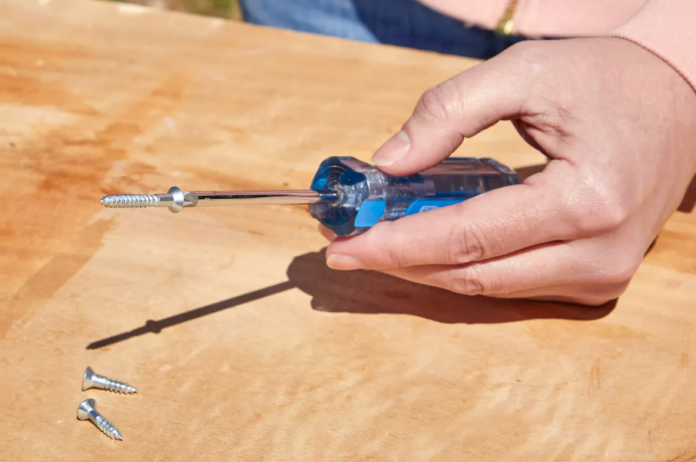Few things are as frustrating as trying to drive a screw into a tight corner or over your head, only to have it fall to the ground just as you’re getting it lined up. Fortunately, the solution to this problem is as simple as grade school science. With a basic understanding of magnetism and a few minutes of effort, you can transform your screwdriver into a tool that securely holds screws in place, making your DIY projects much easier.
The process involves running a neodymium or another rare-earth magnet along the metal shaft of the screwdriver. This aligns the magnetic domains within the metal, causing the screwdriver to attract iron-based items. This trick is especially useful for hand tools like screwdrivers, which will not just lift the screw but hold it in place while you work.
Take just 5 minutes to magnetize a screwdriver today for quicker, easier repairs down the line.
Step-by-Step Guide to Magnetize a Screwdriver
Step 1: Get a Neodymium Magnet
The first step in magnetizing your screwdriver is to obtain a neodymium magnet. These magnets are incredibly strong and are available in various pull forces, typically ranging from ¼ pound to 1 pound. If you don’t already have one, they are easy to purchase online or at hardware stores. Ensure that the magnet is strong enough to magnetize the metal of your screwdriver.
Step 2: Clean the Screwdriver
Before magnetizing your screwdriver, it’s important to clean it thoroughly. Wipe any dirt or debris from all metal parts of the screwdriver with a dry rag or cloth. If the tool is especially dirty, dampen the rag to thoroughly clean the tool, then allow the metal to dry completely before proceeding. A clean surface ensures better magnetization.
Step 3: Slide the Magnet Along the Screwdriver’s Shaft
Hold the screwdriver in one hand and the magnet in the other. Slide the magnet slowly along the tool’s metal shaft from handle to tip, continuing the motion just past the end that will come into contact with the screws. It’s crucial to slide the magnet in one direction only; swiping the magnet back in the opposite direction can undo the magnetism you’ve achieved thus far.
Repeat this motion several times, maintaining a consistent direction. Then, give the tool a quarter turn and repeat the sliding motion. Continue this quarter-turn and stroke process four times. The more strokes you perform (and the higher the iron content in the tool), the more powerful the magnetism will be.
Step 4: Check the Screwdriver’s Magnetism
Once you’ve completed the magnetizing process, it’s time to test the strength of the newly magnetized screwdriver. Touch the driver to a screw and see how well it lifts and holds the fastener. If the screwdriver doesn’t hold the screw as strongly as you’d like, repeat Step 3 to increase the magnetic strength.
Tips and Tricks for Effective Magnetization
- Use a Strong Magnet: The stronger the magnet, the better the results. Neodymium magnets are ideal because of their superior strength.
- Clean Thoroughly: Any debris or oil on the screwdriver can hinder the magnetization process, so ensure the tool is clean.
- Consistent Strokes: Always slide the magnet in one direction to avoid demagnetizing the tool.
- Repeat as Needed: If the magnetism isn’t strong enough, don’t hesitate to repeat the process.
Final Thoughts
Magnetizing your screwdriver is a simple yet highly effective way to make your DIY tasks more manageable. A magnetized screwdriver should retain its magnetism for at least three months, making it a practical addition to your toolkit. However, be cautious, as dropping the tool can disrupt the magnetic alignment. If you need to demagnetize the screwdriver, simply reverse the direction in which you drag the magnet along the shaft—from tip to handle.
With this quick and easy method, you can save time and frustration on your next project. Enjoy the convenience of a magnetized screwdriver, and make your repairs and assemblies a breeze.
Conclusion :
Magnetizing a screwdriver is a simple yet transformative technique that can significantly ease your DIY and repair tasks. By following a few straightforward steps, you can turn an ordinary screwdriver into a tool that securely holds screws in place, reducing the frustration of dropped screws and enhancing your efficiency. This method leverages basic principles of magnetism, making it accessible and quick to implement.
Whether you’re working in tight spaces or overhead, a magnetized screwdriver ensures that your screws stay in place, allowing you to focus on precision and control. Remember to keep your screwdriver clean, use a strong neodymium magnet, and maintain consistent strokes in one direction to achieve the best results. With minimal effort, you can enjoy the convenience and reliability of a magnetized tool.
By integrating this technique into your regular tool maintenance routine, you can ensure smoother, faster, and more efficient repairs and projects. So, take a few minutes today to magnetize your screwdriver and experience the difference it makes. Your future self will thank you for the added convenience and reduced frustration. Happy repairing!
SOURCE OF THE PICTURE / bob vila










